Democracy Disfigured: Opinion, Truth, and the People, Nadia Urbinati (Cambridge, Mass.: Harvard University Press, 2014), 320 pp., $39.95 cloth.
Disruptive Power: The Crisis of the State in the Digital Age, Taylor Owen (New York: Oxford University Press, 2015), 264 pp., $27.95 cloth.
Why Democracy Is Oppositional, John Medearis (Cambridge, Mass.: Harvard University Press, 2015), 272 pp., $39.95 cloth.
Throughout almost the entire history of democracy—from pre-Socratic Greece up to the second half of the twentieth century—its champions faced little difficulty in identifying its enemies. Critics of democracy consistently lined up to attack it on ideological and philosophical grounds. The litany of complaints was familiar: Democracy is an ignorant, unreliable, unstable form of rule; putting power in the hands of the people entrusts decision-making to those who are incapable of making the right decisions, either because of their natural incapacity or because social arrangements have denuded them of their ability to know what they are doing; democratic politicians pander to the masses, and the masses reward them for it; democracies choose short-term gratification over long-term solutions and eventually pay the price. These charges were invariably accompanied by the promise of something better, the assumption being that almost any alternative regime would be an improvement on the inadequacies of democracy.
Over the past quarter century, however, that situation has changed such that democracy no longer has clearly defined ideological or philosophical enemies. Even in those places where electoral democracy is not the default option—notably in China—the appetite to confront its legitimacy head-on and work for its overthrow has been muted. The widespread existence of democratic systems of rule has become a fact of life, seemingly in little need of justification. Of course, that does not mean we live in a world where there is overwhelming satisfaction with democracy. Far from it: democracy has as many critics as ever. But these criticisms are primarily internal, coming from the friends of democracy and aimed at rescuing it from its own weaknesses. At the same time, there is a growing awareness that the greatest threat to democracy may no longer derive from human agency but from new forms of technology, which have the capacity to undermine democracy without anyone having intended it. The forces from which democracy needs rescuing are no longer pressing on it from the outside. They come from within.
***
 Each of these three books deals with the threat that democracy might now pose to itself, though they approach it in very different ways. By far the most significant is Nadia Urbinati’s critique of what she calls the new “democratic Platonism,” by which she means the deployment of arguments that would once have been associated with the philosophical enemies of democracy—like Plato himself—by those who now consider themselves its friends. Plato criticized democracies on the grounds of their inherent superficiality and ignorance; democratic Platonists are those contemporary thinkers who acquiesce in these criticisms while refusing to give up on democracy altogether. Underlying Urbinati’s account is the nagging thought that with friends like these, democracy hardly needs enemies. Urbinati is a political theorist best known for her work on political representation, which she understands as a complex idea whose duality is a necessary condition for the successful functioning of any democracy.[1. Nadia Urbinati, Representative Democracy: Principles and Genealogy (Chicago: University of Chicago Press, 2006).] Representation provides the space within which the two essential features of democratic existence—opinion, which is the consideration of different options, and will, which is the majority decision to select one of them—can coexist without collapsing into each other. She argues that much of the present dissatisfaction with democracy derives from an impatience with the gap between opinion and will and from the desire to bridge it. The critical friends of democracy are looking for ways to make opinion more decisive or to render will better aligned with the truth.
Each of these three books deals with the threat that democracy might now pose to itself, though they approach it in very different ways. By far the most significant is Nadia Urbinati’s critique of what she calls the new “democratic Platonism,” by which she means the deployment of arguments that would once have been associated with the philosophical enemies of democracy—like Plato himself—by those who now consider themselves its friends. Plato criticized democracies on the grounds of their inherent superficiality and ignorance; democratic Platonists are those contemporary thinkers who acquiesce in these criticisms while refusing to give up on democracy altogether. Underlying Urbinati’s account is the nagging thought that with friends like these, democracy hardly needs enemies. Urbinati is a political theorist best known for her work on political representation, which she understands as a complex idea whose duality is a necessary condition for the successful functioning of any democracy.[1. Nadia Urbinati, Representative Democracy: Principles and Genealogy (Chicago: University of Chicago Press, 2006).] Representation provides the space within which the two essential features of democratic existence—opinion, which is the consideration of different options, and will, which is the majority decision to select one of them—can coexist without collapsing into each other. She argues that much of the present dissatisfaction with democracy derives from an impatience with the gap between opinion and will and from the desire to bridge it. The critical friends of democracy are looking for ways to make opinion more decisive or to render will better aligned with the truth.
That democracy is insufficiently attuned either to the need for decisive action or to the higher imperative of truth has always been one of the basic charges against it. Coopting that charge in the name of democracy—in pursuit of a better democracy than we have at present—strikes Urbinati as a fundamental mistake on two levels. It is a philosophical mistake, because antidemocratic arguments weaken rather than strengthen democracy in the long run: Platonism is more likely to eat away at democracy than democracy is to domesticate and neutralize Platonism. But it is also a political misjudgment, because it mistakes the current, unusual prevalence of democracy for a settled state of affairs. Just because the enemies of democracy are no longer at the gate, it does not follow that their ideas have lost their sting. Twenty-five years is not a long time—a mere blip set against more than two and a half thousand years of deep contestation about democracy —and it is not guaranteed to last. It is profoundly complacent to assume that our politics can now experiment with dangerous ideas because the danger to democracy has gone away. It may return before we know it.
Urbinati is far from alone among current political theorists in recognizing that some recent forms of democratic thinking—particularly those associated with populism on the one hand and technocracy on the other—shade into their opposite: antidemocracy.[2. See, for example, Christopher Bickerton and Carlo Invernizzi Accetti, “Populism and Technocracy: Opposites or Complements?” Critical Review of International Social and Political Philosophy (published online April 2015).] What gives Urbinati’s argument its value is the care with which she distinguishes the different varieties of antidemocratic democratism, before identifying what they have in common. In place of the technocratic/populist binary, she offers a three-way distinction among what she calls “epistemic” democracy, “populist” democracy, and “plebiscitary” democracy. These are all related, but they are also distinct. The first has some connection to technocracy, though it is both broader and narrower. Epistemic democrats seek forms of democratic rule that can deliver the correct outcome. This means, among other things, that they prioritize the result of democratic decision-making over the procedure by which it is achieved: a good decision is one that matches up to some external standard of “correctness,” rather than some internal standard of due process.
 Rally at presidential residence, Bratislava. (Credit: Miroslav Petrasko/Creative Commons)
Rally at presidential residence, Bratislava. (Credit: Miroslav Petrasko/Creative Commons)
Urbinati argues that this misses the normative point of democracy, which is to allow free and equal participation in decision-making, regardless of the decision made. It also collapses the necessary distinction between opinion and will, because it seeks to ensure, often under the guise of majoritarianism, that will (or choice) is always guided by true opinion. Some epistemic democrats are champions of Condorcet’s jury theorem, which establishes a link between majority opinion and correct outcomes; others go under the label of “deliberative democracy,” which seeks to turn majority decision-making into a species of juristic deliberation. Alternatively, it can come in the form of attempts to detach democratic decision-making from public opinion altogether by empowering unelected experts, whether judges or central bankers. In the latter case, the link to technocracy is clear: expertise stands in place of the messy business of allowing diverse opinions and decisive outcomes to coexist. But in all cases, epistemic democracy is intolerant of mess because it mistakes the endlessly revisable results of democratic procedures for an inadequate attachment to the right outcome. For Urbinati, by contrast, the ability of any democracy to revise its decisions is a sign that it is functioning successfully, because it indicates that neither opinion nor will can have it all its own way: any decision is subject to the pressure of shifting opinion, just as any opinion is subject to the pressure of having to reach a decision.
Populism offers a mirror image of epistemic democracy. It, too, is impatient with messy and inconclusive political procedures, but it takes the side of will over opinion in an attempt to shut down the space between them. Populists champion “the pure many” over “the corrupt few” and they presume that the people have right on their side. This is not because popular decision-making produces the right result as measured by some external epistemic standard, but because rightness itself can be defined by popular participation: if the people say it, that makes it true. However, as Urbinati points out, though populism sets itself against the measures by which epistemic democrats judge political outcomes (and it certainly sets itself against the bankers and lawyers who are empowered to achieve them), it often ends up looking a lot like the elitism it ostensibly opposes. Populists disdain representation, which they juxtapose with the openness of participatory politics. Yet by closing off the dualism of representative politics, populism opens the door to new kinds of elites, who deploy the name of “the people” to silence rival opinions. Populism is particularly dismissive of legislative bodies that represent a range of political views. In that sense, populists are anti-pluralists. Any form of democratic politics that seeks to circumvent the legislature is flirting with antidemocracy. That is as true of populist appeals to the street as it is of epistemic appeals to a higher truth.
Perhaps the most original part of Urbinati’s argument comes in her account of plebiscitary democracy. Plebiscites are often assumed to be a form of populism, because they involve direct appeals to the people and invoke their ability to reach definitive decisions (that is the idea behind referendums, which are usually regarded as the quintessential form of “plebiscite,” though recent European experience suggests that referendums are rarely as decisive as they appear). Urbinati, by contrast, distinguishes plebiscitary politics from populism on the grounds that it reduces the public to the role of spectators, not participants. Plebiscitary democracy is a form of theatre in which political leaders parade both opinions and decisions before the people and invite their approval. It makes the public passive and reactive, a mere receptacle for the real action taking place elsewhere.
It is true that plenty of political theorists have moved between populist and plebiscitary modes, sometimes seeking to drag the people into the heart of political decision-making and at other times wanting to keep them at a safe distance from it. Carl Schmitt, on this account the arch antidemocratic democrat of the first half of the twentieth century, features in Urbinati’s descriptions both of populist and of plebiscitary democracy. That, however, does not detract from the force of her distinction between them. Populists invoke the people’s voice, even if they ultimately become its mouthpiece. Plebiscitary democrats reduce politics to a matter of visuals— it is “ocular” rather than “vocal” in its mode of engagement, to use Urbinati’s slightly clumsy phrasing. Looking on is no substitute for taking part. For this reason, plebiscitary politics often comes closer to epistemic democracy than it does to the populist version. It tries to keep the substantive diversity of popular opinion at arm’s length in pursuit of something cleaner, which can then be presented back to the public as being in its own interest. Plebiscitary democracy seeks to insulate the decision-makers from the pressure of having to answer to rival opinions before they have imposed one of their own.
As a political theorist, Urbinati is most exercised by the epistemic challenge to democracy, given the prevalence of deliberative schemes currently being touted by philosophers. Deliberative democracy is everywhere on paper at the moment, but rarely in evidence beyond that. As a citizen, it is the real world prevalence of plebiscitary democracy that alarms her. Urbinati’s “diarchic” conception of representative democracy, with its separate but interconnected spheres of opinion and will, depends on barriers existing in the way of either being able to monopolize the other, but also in the way of either being able to cut itself off from the other. “The insulation of the political system from socioeconomic power,” Urbinati writes, “must be achieved without blocking the connection between society and institutions, which is . . . one of the most important features of representative government and what makes it diarchic” (p. 237).
 President Woodrow Wilson (Credit: Harris and Ewing, Public Domain/Wikimedia Commons).
President Woodrow Wilson (Credit: Harris and Ewing, Public Domain/Wikimedia Commons).
The danger of plebiscitary democracy is that it creates a gulf between political actors and their audience, who can either approve or disapprove of what has been decided but cannot participate in the process by which it was done. Of course, that is what plebiscitary democrats like about it. Urbinati cites the example of Woodrow Wilson, who believed that holding the confidence of the people counted for far more than being accountable to them. “Persuasion is a force,” Wilson said, “but not information; and persuasion is accomplished by creeping into the confidence of those you would lead” (p. 179). Wilson is sometimes assumed to have been a technocrat, who treated democratic politics as a species of educated problem solving. For Urbinati, by contrast, he was really a plebiscitarian par excellence. Because Wilson was also an internationalist, he exemplifies the pull of plebiscitary politics in an age of growing international interconnectedness. It is the plebiscitary politics of the European Union that worries Urbinati more than its technocratic tendencies, given the space it creates for grandstanding by relatively unaccountable policymakers. However, it is the specter of one national politician in particular who looms largest over this book. Urbinati is Italian, and for her, quite understandably, the worst of plebiscitary politics is embodied by Silvio Berlusconi, whom she describes as having reigned as the “de facto plebiscitarian leader of an audience democracy” (p. 209). Berlusconi’s domination of the Italian media—and in particular of Italian television—enabled him to turn democratic politics into a voyeuristic spectacle. This, for Urbinati, exemplifies the perils of making transparency a political virtue: the more we see, the more remains hidden. Turning democratic politics into “an object of spectacle may engender a new opacity under the pretense of publicity” (p. 210).
Berlusconi is a good illustration of the force of this argument, but also of its limits. He remains a distinctively late twentieth-century politician—media baron, tycoon, master manipulator, and smiling pragmatist—and Urbinati describes his form of rule in terms that now seem somewhat dated. She says it is “video democracy” that allows the owners of mass media outfits—including television stations and the newspapers that promote their content—to hold sway over “homo videns, a television-made animal whose mind is no longer shaped by concepts, by abstract mental constructs, but by images” (p. 210).[3. Urbinati is here quoting from Niklas Luhmann, The Reality of the Mass Media, trans. Kathleen Cross (Stanford, Calif.: Stanford University Press, 2000).] Yet the biggest change of the past twenty-five years is that we no longer live in the television age. Ours is now the age of the Internet. Curiously, Urbinati barely mentions digital technology, and when she does she assumes it is merely an extension of what has gone before. Online citizens are seen as just another gawping crowd of spectators, responding to superficial affects and banal images, whose ready accessibility conceals their lack of substantive engagement with political decision-making. She may be right. But it cannot simply be assumed that television-made politics and the Internet-made version will share the same failings.
The web is not only an ocular medium—there are as many avenues for voice as there are for visuals—nor is it one in which a clear line can be drawn between the manipulators and the manipulated. Television depends on transmission, which makes communication inherently one-way. Digital technology is the great enabler of networks, whose lines of communication and influence move in multiple directions. Furthermore, it seems almost absurd to believe that dominant power currently lies with the owners of television stations and newspapers. Their monopolies have been irredeemably fractured by a plethora of online rivals, competing for multiple new audiences. Yet it is not as if the age of monopoly is itself dead. The past decade has seen the growth of new monopoly powers on a scale that Berlusconi or Rupert Murdoch could only dream of. Facebook, Amazon, Google, and Apple (and before them, Microsoft) have a range of products, levels of influence, and access to information and means of controlling it that are unprecedented, and that have given them unprecedented resources, both material and (potentially) intellectual. Unlike previous media moguls, these new corporate behemoths claim to be above politics, but it is hard to see how that can be true.[4. This attitude is exemplified by the Silicon Valley entrepreneur and technology evangelist Peter Thiel (cofounder of PayPal and early investor in Facebook), who has repeatedly stated that solutions to our current problems must be found outside politics and will be driven by technology itself. “Political skirmishes over inequality are to him the historical equivalent of fighting over how doctors should be distributing leeches to the poor . . . . From this vantage point, government is not so much the harbinger of evil as an ineffective nuisance.” See Gregory Ferenstein, “Peter Thiel’s Radical Political Vision,” Daily Beast, www.thedailybeast.com/articles/2014/10/01/peter-thiel-s-radicalpolitical-vision.html.] Again, Urbinati discusses none of this.
***
 By taking it for granted that an argument whose premises derive from the era of analog communication can be extended into the digital age, Urbinati sets herself against a growing body of thought that assumes the opposite. Taylor Owen’s Disruptive Power is emblematic of this rival trend. For Owen, almost all the premises about how political institutions function have been thrown into question over the past two decades. In particular, the nation-state faces an array of disruptive forces that threaten to undermine its ability to function. Owen sees the primary disruption as coming from new forms of connectivity, which make it much harder for states to retain a meaningful hold over the lives of their citizens. Individuals can now bypass the state, they can evade its grip, and they can communicate their dissatisfaction with its decisions in ways that were previously either costly or simply impossible.
By taking it for granted that an argument whose premises derive from the era of analog communication can be extended into the digital age, Urbinati sets herself against a growing body of thought that assumes the opposite. Taylor Owen’s Disruptive Power is emblematic of this rival trend. For Owen, almost all the premises about how political institutions function have been thrown into question over the past two decades. In particular, the nation-state faces an array of disruptive forces that threaten to undermine its ability to function. Owen sees the primary disruption as coming from new forms of connectivity, which make it much harder for states to retain a meaningful hold over the lives of their citizens. Individuals can now bypass the state, they can evade its grip, and they can communicate their dissatisfaction with its decisions in ways that were previously either costly or simply impossible.
Owen follows Manuel Castells in suggesting that connection has replaced representation as the primary locus of power.[5. See Manuel Castells, “Information Technology and Global Capitalism,” in Will Hutton and Anthony Giddens, eds., On the Edge: Living with Global Capitalism (London: Jonathan Cape, 2000).] He treats representation as an essentially hierarchical form of politics—power moves up to the representatives and then back down again—and he argues that digital technology now confronts representative politics with a multiplicity of new horizontal relationships. Democracy needs to adapt to these new forms of connectivity or it risks losing control of them, with unforeseeable consequences. Owen recognizes that a degree of hierarchy is necessary for states to continue to function. He does not share the blind enthusiasm of some champions of the new technology for ceaseless, horizontal experimentalism. States need stability and they have obligations to provide security for their citizens, which cannot be met by constant disruption. He also acknowledges that digital technology does not simply break up established hierarchies; it also creates new ones. Here, though, his vision looks rather blinkered. He does not pay much attention to the vast reach of monopolistic social networks, such as Facebook—which can empower novel horizontal relationships within its own domain, but which faces the outside world as an exceptionally closed and vertically integrated actor (there are few more secretive or inaccessible organizations anywhere than the new technology monoliths).
Owen’s interest is the ways in which the state can deploy technology to bolster its own power by means of enhanced surveillance. So what he is describing are essentially two competing trends: one toward the disaggregation of state power under pressure from digital networks and the other toward the reaggregation of state power through new forms of domination, both empowered by the same technology. This arms race—the horizontal versus the vertical—threatens to do terminal damage to democracy by pitting connectivity against state control. Owen believes we need to find some way of reconciling them, and he ends with a plea for states to accommodate disruption and transparency despite the risks, in order to be better attuned with the spirit of the age.
The problem with this argument is that it does not have a plausible theory of democratic politics to underpin it. Instead, Owen treats democracy as something that contains two elements that could pull it in one of two directions: either toward or away from greater state control. He cannot explain how to bring them together, because he puts representation on one side of the divide (as a form of state control). In other words, his account lacks exactly what Urbinati’s provides, which is an explanation of how the two sides of representative democracy—diversity of opinion and singularity of decision—can and must coexist without collapsing into each other. Absent a theory of democracy, all Owen can give us is reportage about the disruptions he has witnessed. He evinces enthusiasm for some, coupled with intermittent hand-wringing about the damage others could do to the authority of the democratic state. Disruptive power, for Owen, is both good and bad for democracy. What he does not explain is how the good and bad can be reconciled.
For instance, unlike Urbinati, Owen simply takes it for granted that enhanced visibility and transparency are good for democracy, so long as it is citizens rather than states that are doing the watching. In a chapter entitled “Being There” he describes how new technology can engender fresh forms of engagement through the immediacy of witnessing the suffering of others: we are no longer limited to reading about war zones, we can experience them firsthand. He quotes one of the evangelists for an age of hypervisibility, Sam Gregory of the human rights nongovernmental organization Witness: “Live video shot via wearable computers such as Google Glass and synchronous multi-sensory experiences can create an immersive experience that allows us to emotionally connect, to empathize with others in a way that fundamentally changes our understanding of one another” (p. 102). How this new empathy might translate into political action is never explained.
 Obama's national security team. (Credit: Pete Souza/Official White House Photo)
Obama's national security team. (Credit: Pete Souza/Official White House Photo)
On the other hand, Owen worries about the ways that the state can exploit the surveillance capabilities of digital technology to manipulate, control, and occasionally destroy individuals around the world. Warfare now includes an extraordinary range of ways for remote actors to watch the action as it unfolds. The famous photograph of Obama’s national security team (including Hillary Clinton, hand over mouth) viewing the raid that led to the death of Obama bin Laden as it was unfolding captures this new immediacy. But however you read Hillary’s gesture, it is hard to see this as an extension of empathy. Less empathetic still is the surveillance undertaken by the National Security Administration, which seeks to monitor as much global online communication as possible. Thanks to Edward Snowden, we know the mantra under which this program was being conducted: “Collect it All; Process it All; Exploit it All; Partner it All; Sniff it All; Know it All” (p. 15). “Ocular politics” seems an inadequate term to capture such a level of ambition. This is surveillance as machine learning, with systems substituting for human witnesses, in order to extract usable patterns from the metadata.
The contrast Owen is drawing could hardly be clearer: empathetic visibility is a boon, whereas mechanistic visibility is a threat. But the gap between them as presented here is so great that it is hard to see how it can be bridged. The only thing that can bridge it is a theory of political representation. Otherwise, empathy will remain superficial—or, as Urbinati would put it, “spectatorial”—and surveillance will continue unstoppable. A similar problem holds for Owen’s account of the new kinds of “voice” allowed by the digital age. It is now possible for national politicians to speak directly to people around the world, bypassing the need for traditional forms of diplomacy. Likewise, citizens can speak back, using social media and other online tools to let politicians know how their messages were received. Owen cites Obama’s Cairo speech of 2009, in which the president made a direct appeal for tolerance to Muslim populations by discussing his own personal experiences of Islam, as an example of what can be achieved, though Owen complains that the transformative potential of this rhetoric was stymied by the failure of U.S. foreign policy to embrace its disruptive possibilities (there was no corresponding change of course in the Middle East). It seems more likely that it failed because it represented a narrow form of plebiscitary politics. In this respect, it was nothing new. One of Woodrow Wilson’s illusions was his belief that he could speak directly over the heads of national politicians to national populations in the aftermath of World War I, appealing to their collective desire for peace (for instance, Wilson published newspaper addresses to the Italian people in April 1919 when he ran out of patience with their representative at the Paris peace negotiations). He failed because appeals of this sort are inherently limited: they ask only for approval, not for serious engagement (Italian public opinion turned out to be quite different from how Wilson had imagined it). Plebiscitary politics is more accessible in the age of the Internet, but that does not make it any less incomplete.
What Owen offers to fill the gap between the new technology’s enabling and disabling potential for democracy is simply a plea for more imaginative use of that technology, coupled with some wishful thinking. For instance, he suggests that Twitter can stand in for some of the things we are currently missing from our politics: it can supply what he calls “instantaneity, solidarity and information from trusted elites” (p. 117). In other words, we get plebiscitary democracy (visibility without understanding), populist democracy (connection without coherence), and epistemic democracy (information without accountability). This is not a solution; it is a description of the problem. These narrow conceptions of democracy cannot fruitfully coexist. They compete to occupy the same space.
***
John Medearis recognizes the profound difficulty of finding any neat solutions to this problem in his book Why Democracy is Oppositional, which has no illusions about the internal coherence of contemporary democratic politics. Medearis believes that any democracy will be the site of fierce competition between those who are empowered by its institutional arrangements and those who are constrained by them. Under these circumstances, active confrontation with the authority of the state is unavoidable, because any democratic settlement will be profoundly unequal in the political opportunities it creates.
 Medearis is a champion of social movements that offer the disadvantaged an opportunity to assert themselves against the established democratic order— many of them, like Occupy Wall Street, enabled by the new technology. Notwithstanding this emphasis on digital politics, which is missing entirely from Urbinati’s book, he has much more in common with her account than he does with Owen’s. He is, like Urbinati, a critic of ocular conceptions of politics, which envisage citizens as spectators (something all three books share is an engagement with Jeffrey Green’s book The Eyes of the People: Democracy in an age of Spectatorship, though Owen is the only one to approach it relatively uncritically).[6. Jeffrey Green, The Eyes of the People: Democracy in an Age of Spectatorship (New York: Oxford University Press, 2010).] Medearis also sees democracy as a process—“a continual, immersive, never-ending cycle of political action”—against those who would identify it with a series of outcomes (p. 49). He shares Urbinati’s emphasis on the normative value of democracy as procedure, and both authors want to rescue this idea from the narrow, non-normative proceduralism associated with neo-Schumpeterian conceptions of democracy as mere competition for votes (Medearis’s previous book was a rich account of the neglected dimensions of Schumpeter’s thought).[7. John Medearis, Joseph Schumpeter’s Two Theories of Democracy (Cambridge, Mass.: Harvard University Press, 2001).] What are sometimes called “minimal” theories of democracy—justifications for democratic practice in the bare terms of an ability to rotate governments without resort to violence—are inadequate for Medearis and Urbinati. Such theories miss the dynamic value of contestation and neglect the ways in which democracy is, as Medearis puts it, a part of “day-to-day experience” (p. 70). Understanding democracy as procedure leaves its outcomes permanently open to improvement. That is what makes it worth defending.
Medearis is a champion of social movements that offer the disadvantaged an opportunity to assert themselves against the established democratic order— many of them, like Occupy Wall Street, enabled by the new technology. Notwithstanding this emphasis on digital politics, which is missing entirely from Urbinati’s book, he has much more in common with her account than he does with Owen’s. He is, like Urbinati, a critic of ocular conceptions of politics, which envisage citizens as spectators (something all three books share is an engagement with Jeffrey Green’s book The Eyes of the People: Democracy in an age of Spectatorship, though Owen is the only one to approach it relatively uncritically).[6. Jeffrey Green, The Eyes of the People: Democracy in an Age of Spectatorship (New York: Oxford University Press, 2010).] Medearis also sees democracy as a process—“a continual, immersive, never-ending cycle of political action”—against those who would identify it with a series of outcomes (p. 49). He shares Urbinati’s emphasis on the normative value of democracy as procedure, and both authors want to rescue this idea from the narrow, non-normative proceduralism associated with neo-Schumpeterian conceptions of democracy as mere competition for votes (Medearis’s previous book was a rich account of the neglected dimensions of Schumpeter’s thought).[7. John Medearis, Joseph Schumpeter’s Two Theories of Democracy (Cambridge, Mass.: Harvard University Press, 2001).] What are sometimes called “minimal” theories of democracy—justifications for democratic practice in the bare terms of an ability to rotate governments without resort to violence—are inadequate for Medearis and Urbinati. Such theories miss the dynamic value of contestation and neglect the ways in which democracy is, as Medearis puts it, a part of “day-to-day experience” (p. 70). Understanding democracy as procedure leaves its outcomes permanently open to improvement. That is what makes it worth defending.
Yet despite these overlaps, Medearis falls foul of the test Urbinati sets for democratic theory: his argument in the end blurs into populism. The dualism he posits is between the capture of democracy by elites and the rival ability of the people to channel their own will and energy into political decision-making. Medearis has a very broad understanding of how the people’s will might be expressed: the point of his “oppositional” theory of democracy is to indicate that democratic action can manifest itself in a wide variety of social settings, wherever political oppression is felt. “The list of democratic activities,” he argues, “should be more extensive than most contemporary approaches allow” (p. 131). It includes consumer boycotts, workers’ protests, and many different forms of spontaneous action. Medearis avoids the pitfalls of crude populism. He does not think it is easy to voice the will of the people, because it can never be pinned down. Anyone claiming to be its unique mouthpiece is lying. Democratic decision, Medearis says, is best understood as “ongoing, reflexive action.” He continues: “It is surely important for democratic theory to conceptualize the limits of democratic action—and the continuous reappearance of the problems that call it forth” (p. 50). So there is nothing simplistic about this analysis. Medearis recognizes the ways in which popular politics runs up against the constraints of its own tendency toward diffusion. Elites cannot simply be banished by a unified people. They have to be permanently contested by a dispersed one.
This conceptual sophistication, however, does not rescue Medearis from what Urbinati identifies as the central failing of populist conceptions of democracy, which is an inability to bridge the gap between the people and their representatives. It is a failure most evident in the final chapter of Medearis’s book, which is also the most striking. Whereas the main body of his text is broadly optimistic as it recounts the ongoing capacity of social movements to confront elite power, he is much less sanguine when he turns to the emergence of a new kind of security state, enabled by the new technology. The massive surveillance currently being undertaken by the state is being done in the name of the public interest; yet at the same time it is far removed from anything the public could itself monitor or perhaps even comprehend. “The most significant new institutions and powers of the security state,” Medearis writes, “direct the consequences of combat or surveillance away from any public that could organize to manage them” (p. 206).
It is very hard to oppose something that most people almost never experience firsthand. If the rationale of security state operations—from drone warfare to metadata mining—is to introduce a technological prophylactic between ordinary citizens and the things being done to keep them safe, then it is hard to see how popular politics can continue to function. At this point, oppositional democracy reaches a dead end. As Medearis writes: “Real popular engagement with these issues may only follow from—not trigger—a restructuring of the security that aligns its dangers more closely with what the public experiences and fully understands. But, troublingly, it is not clear whether there are any tendencies leading toward such a reform” (p. 213). It is a classic chicken-and-egg problem: the security state will not reform until it encounters resistance; but it will not encounter resistance unless it reforms.
This is the dead end of populism in a plebiscitary age. Any conception of democracy that relies on the reactive power of the people also depends on there being something to react against. That will not work if the people are subject to forms of power that insulate them from the consequences of what is being done in their name. Urbinati’s theory of democracy does not fall into this trap because it is diarchic rather than dualistic. A dualistic theory pits one form of power against another. A diarchic theory couples the two sides of power in a process that is designed to force them to coexist. Representative institutions, in which political decision-making has to take place alongside a real diversity of opinion, are the only means for regaining democratic control of the security state. That does not mean it is going to happen. Owen is right that the digital age also poses significant challenges for representative politics, above all because of the premium that the new technology places on speed. On Urbinati’s account, the resource that representative democracy needs more than anything else is time. This is not the time insisted on by epistemic democrats, that is, sufficient time to talk through the options until we arrive at the true answer. Rather, representative democracy requires the time to revisit decisions already taken, especially those taken in haste, in order to be able to revise them. It is, as Urbinati says, an endless process, because democracy is nothing without the ability to think again. Second thoughts are the essence of democracy, but they are not the essence either of the digital revolution or of the security state, both of which are best understood as the overlaying of rapid decisions and fresh disruptions one on top of the other.
The other challenge for any current theory of democracy is how to deal with the power of the new monopolists of the digital space. Urbinati’s remedy for the convergence of socioeconomic and political power—as exemplified by Berlusconi—is to argue for reinvigorated representative institutions capable of breaking it up. Recent attempts by the European Union to challenge the outsized hold of Google over online search and related services might fit this mold. Ironically, the EU itself suffers from the hollowness of its own representative institutions, which are too far removed from the dynamics of democratic politics on a national level. It constitutes an epistemic or plebiscitary approach more than it does a democratic one. Equally, Google appears a very different entity from Berlusconi and his media/business empire: it is far more powerful but capable of seeming less so, because its power does not conform to the “video democracy” stereotype. Google is not trying to unify communication in a given political space. It is simply amalgamating data and then perpetually recalibrating the means by which people have access to it, in order to protect its primary source of revenue, which is advertising. We are both the producers and the consumers of its services. That makes it difficult to know where representative institutions could interpose themselves on our behalf. The power of the new technology giants appears to be nonpolitical precisely because it is potentially so pervasive. That is what makes it a threat to representative democracy.
 Google. (Credit: Carolos Luna/Creative Commons)
Google. (Credit: Carolos Luna/Creative Commons)
When Google’s political power does manifest itself it tends to be in the name of epistemic democracy. New technology is often held up by the champions of what Urbinati labels “solutionism” as a means to achieve better, smarter, and more efficient outcomes. Solutionism is often accompanied by a push for greater transparency, on the assumption that good outcomes will be enhanced if we can have greater knowledge of what people are up to—both politicians and citizens. This is where epistemic and plebiscitary forms of democracy join hands. Dave Eggers’s recent novel The Circle is a dystopian satire on what might follow.[8. Dave Eggers, The Circle (New York: Random House, 2013).] In this vision of the near future, politicians are forced to wear digital monitors that record everything they get up to at any given moment so we can be sure they are hiding nothing from us. Justice is put in the hands of social networks, which can “solve” crime by pooling their collective resources to trace absconded criminals. In Eggers’s dystopia, a virtual crowd of millions is able to track anyone in the world in a matter of minutes. The crowd then eggs on its representatives on the ground—the people with the cameras—to lynch its prey. This is a chilling version of Tocqueville’s tyranny of the majority reconfigured for the digital age.
Urbinati is silent on this possible future or any of the possible alternatives to it. But she does provide the tools to start thinking about it, which is the fundamental, neglected task of contemporary political theory. Owen and Medearis identify some of the challenges posed to representative democracy by the digital age on which we have embarked. But they lack the conceptual means to go further than that. Urbinati’s Democracy Disfigured is a major contribution to the theory of democracy in the twenty-first century and the best place to begin.
--David Runciman
More in this issue
Fall 2015 (29.3) • Feature
Unethical Consumption and Obligations to Signal
To bring about an end to the harms involved in the production of everyday goods, what should the individual do?

Fall 2015 (29.3) • Review
The Paradox of Liberation by Michael Walzer
REVIEW BY GEORGE RUPP This book provides a masterly refutation of a remarkably resilient array of stereotypes about religion and secularism.

Fall 2015 (29.3) • Essay
International Judges: Is There a Global Ethic?
RICHARD J. GOLDSTONE Thousands of judges from across the globe now sit on international courts. It is time to systematically consider professional ethical standards.
